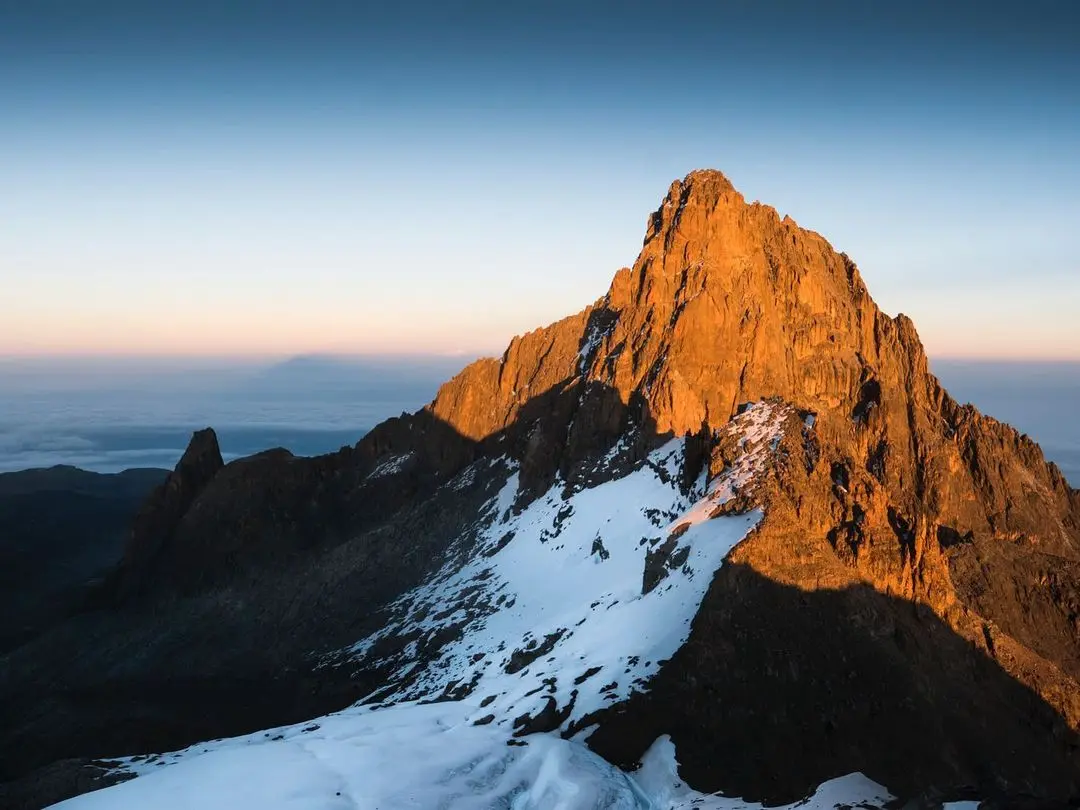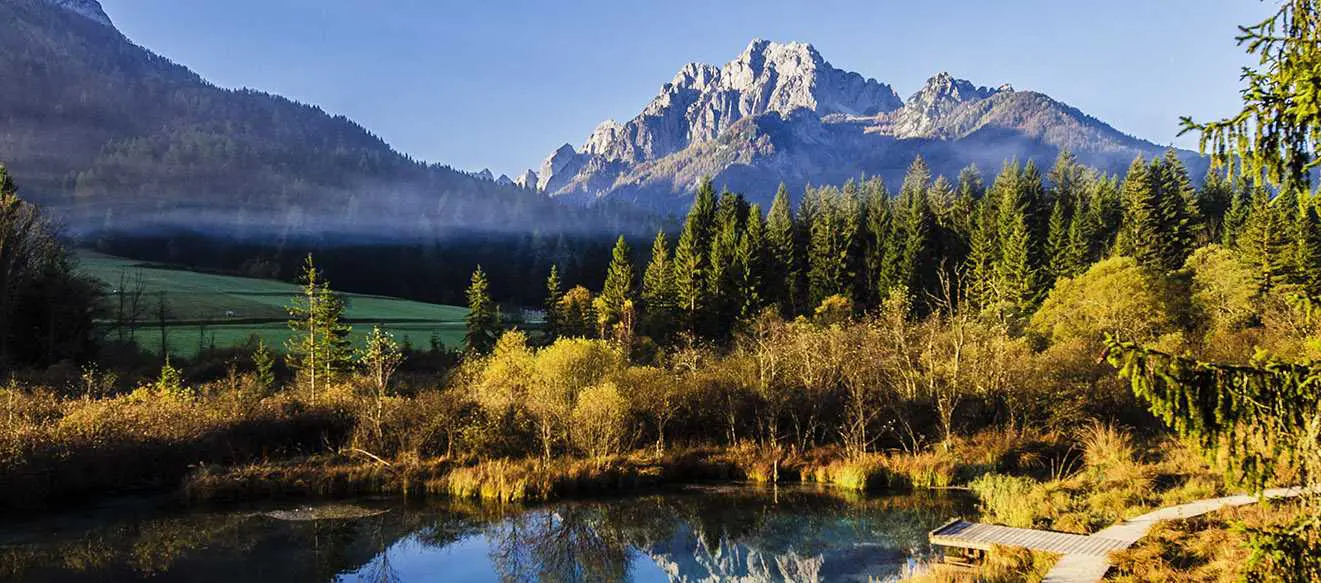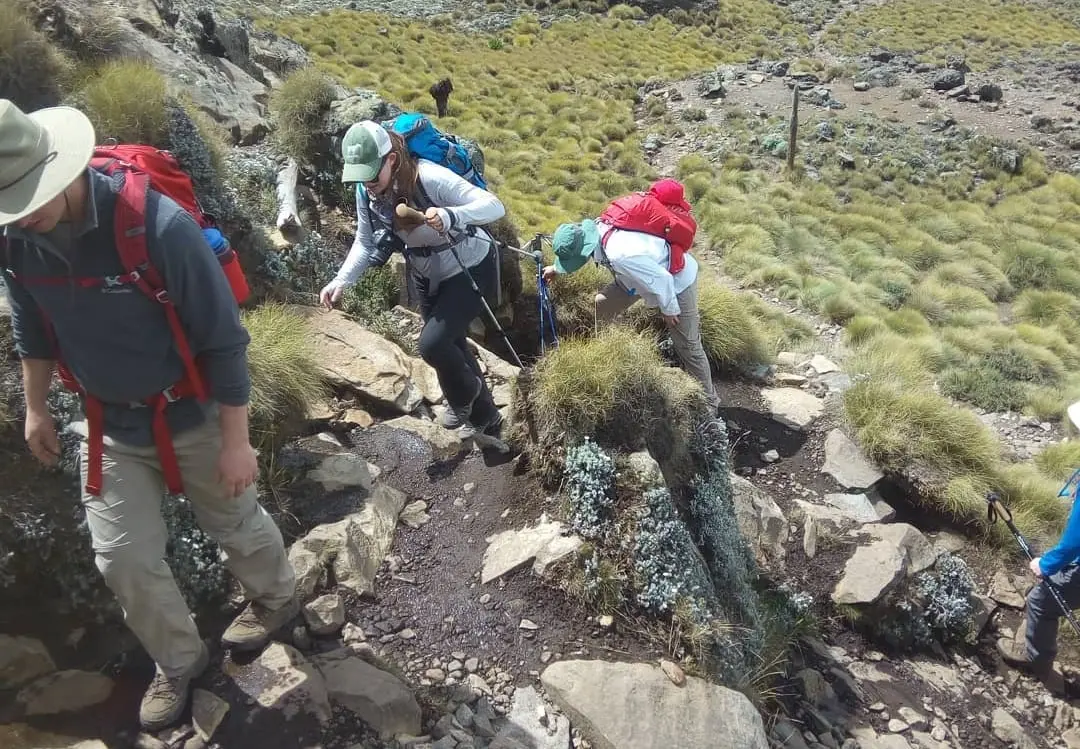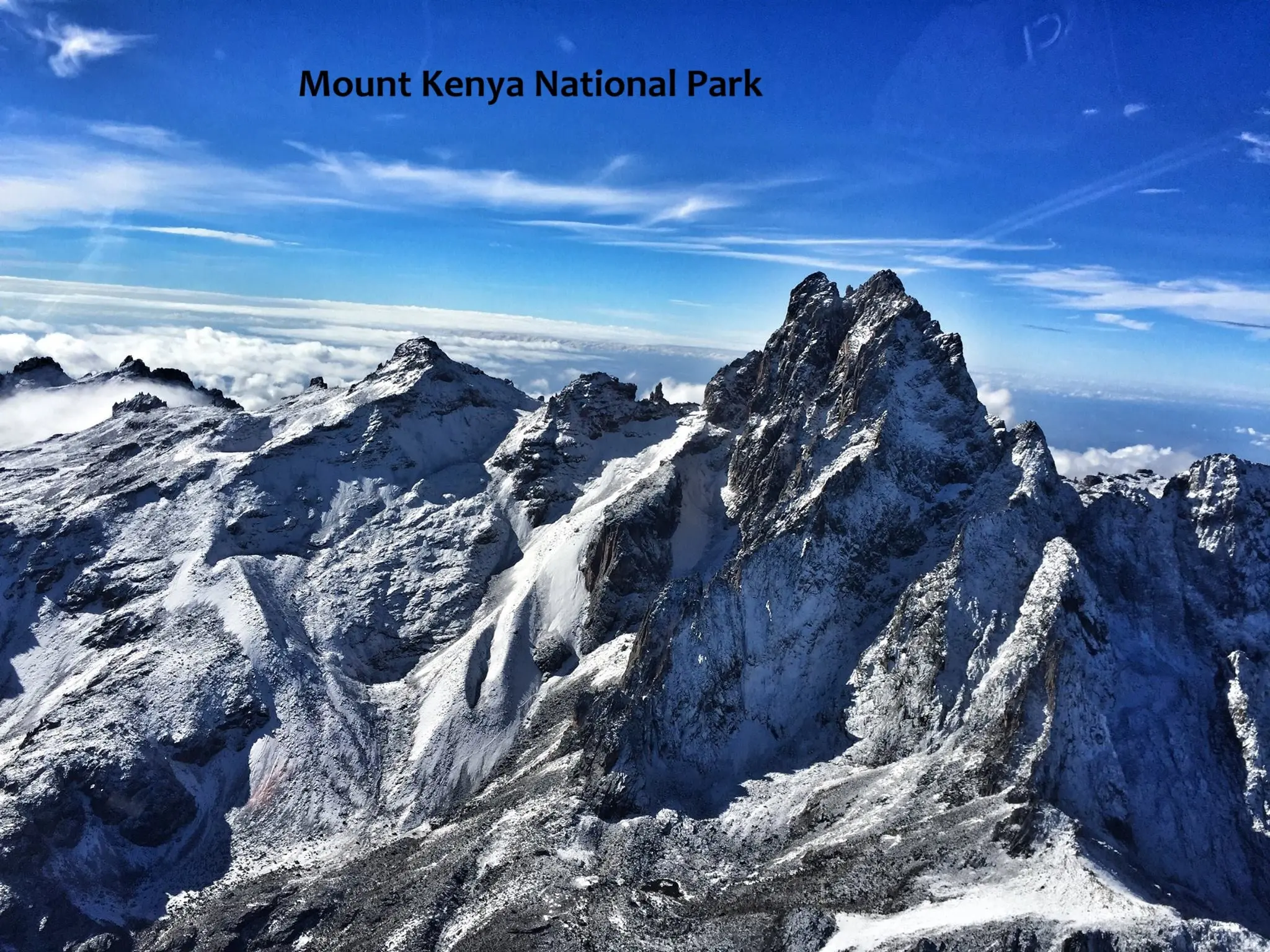
Mount Kenya National Park is a national park that was established
in 1949. The park was established to protect Mount Kenya which is the second largest mountain in Africa.
The park is renowned natural wonder located in Kenya, approximately 175 km
northeast of Nairobi. Mt. Kenya NP was created to protect the majestic Mount
Kenya, its diverse wildlife, and the surrounding environment.
Mount Kenya is the second highest mountain in Africa and has
a peak elevation of 5,199 meters (17,058 feet). The Park offers breathtaking
landscapes and a unique ecological system. Mount Kenya national park covers an
area of 715 square kilometers (276 square miles).
The park is a popular destination for nature enthusiasts,
hikers, and those seeking adventure amidst stunning natural beauty.
Location of Mt. Kenya
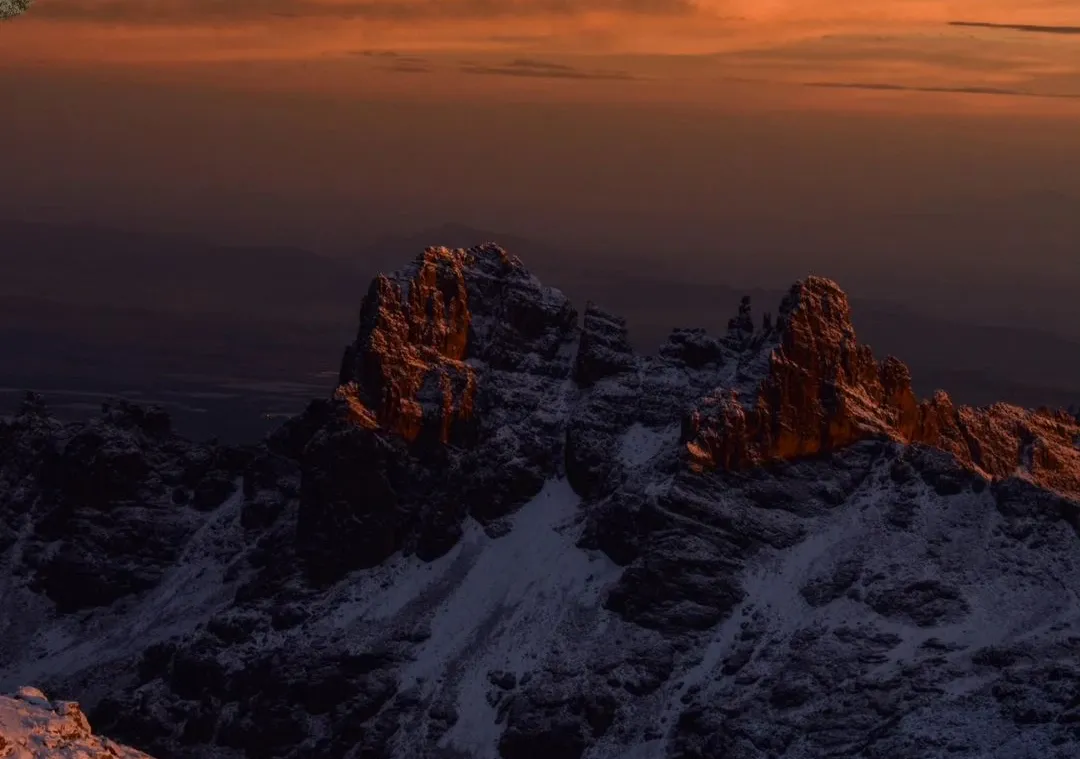
Mount Kenya National Park is located in central Kenya, approximately 175 kilometers (108 miles) northeast of Nairobi city. This strategic location makes the park easily accessible for both domestic and international tourists. Learn more about the location of Mount Kenya National Park.
The park is located around Mount Kenya, an ancient volcanic
mountain that stands as the second highest peak in Africa, after Mount
Kilimanjaro.
Key Features and General Information
The park covers an extensive area of 715 square kilometers
(276 square miles), with the majority of its terrain lying above the
3,000-meter (9,800 feet) contour line. This elevation ensures that visitors are
treated to a diverse range of ecosystems, from dense forests and woodlands at
lower altitudes to alpine meadows and snow-capped peaks at higher elevations.
The park is renowned for its stunning natural beauty, which
has earned it a place on the UNESCO World Heritage list since 1997.
Additionally, it was designated a UNESCO Biosphere Reserve in 1978,
underscoring its ecological significance.
Mount Kenya National Park is home to an incredible variety
of plants and animal species. Visitors can expect to encounter elephants, buffaloes,
leopards, and monkeys, along with over 130 species of birds.
The park's landscape is dotted with picturesque lakes and
tarns, providing serene spots for relaxation and photography. The presence of
12 remnant glaciers, though rapidly receding, adds to the park's dramatic and
rugged beauty.
Significance of Mount Kenya

Mount Kenya as the Second Highest Mountain in Africa
Mount Kenya stands proudly as the second highest mountain on
the African continent, with its highest peak, Batian, reaching an elevation of
5,199 meters (17,058 feet). This towering presence is surpassed only by Mount
Kilimanjaro. Mount Kenya has 3 main peaks and other smaller peaks that creates an enticing challenge for mountaineers and hikers from around
the world.
Geological Features of the Mountain
Mount Kenya is an ancient, extinct volcano that last erupted
millions of years ago. Its volcanic origins have shaped the mountain into a
striking and rugged landscape, characterized by steep cliffs, deep gorges, and
a variety of geological formations.
The mountain's three main peaks—Batian, Nelion, and Point
Lenana—offer varying degrees of climbing difficulty, attracting both seasoned
climbers and adventurous trekkers.
The 12 remnant glaciers of Mt. Kenya, though rapidly receding due
to climate change, are a testament to the mountain's glacial history. These
glaciers, along with the U-shaped glacial valleys and moraines, provide a
fascinating glimpse into the mountain's geological past and its dynamic natural
processes.
Mount Kenya's diverse landscapes range from thick montane
forests and bamboo zones to high-altitude heathlands and alpine moorlands. This
variety of ecosystems supports a wide array of plant and animal species, many
of which are endemic to the region.
The unique flora, such as the giant lobelias and groundsels,
adds to the mountain's ecological richness and beauty.
Area of Mount Kenya NP and Elevation Range
Mount Kenya National Park spans an impressive area of 715
square kilometers (276 square miles), making it one of the largest national
parks in Kenya. This expansive park encompasses a variety of landscapes, from
dense forests and bamboo thickets at lower altitudes to open moorlands and
alpine vegetation at higher elevations.
The park's large area allows for the protection of a diverse
range of ecosystems and wildlife habitats, ensuring the conservation of
numerous species.
Elevation Range and Significance of the 3,000-Meter Contour Line
The majority of Mount Kenya National Park lies above the
3,000-meter (9,800 feet) contour line, which is significant for several
reasons. At this altitude, the park transitions into high-altitude ecosystems
that are distinct from the lower forested areas.
These higher elevations are characterized by unique plant
and animal species that have adapted to the colder temperatures and reduced
oxygen levels.
The park's elevation range extends from approximately 2,400
meters (7,874 feet) at its lowest point to the summit of Mount Kenya at 5,199
meters (17,058 feet). This considerable elevation gradient creates a range of
climatic zones within the park, each supporting different types of vegetation
and wildlife.
For example, the montane forests found at lower elevations
give way to bamboo and heath zones, which then transition into alpine meadows
and rocky peaks at higher altitudes.
The 3,000-meter contour line is also significant because it
marks the boundary above which the park's iconic glaciers and snow-capped peaks
are found.
These glacial areas are not only visually stunning but also
play a crucial role in the park's water catchment functions, providing a source
of fresh water for the surrounding regions.
Wildlife Diversity
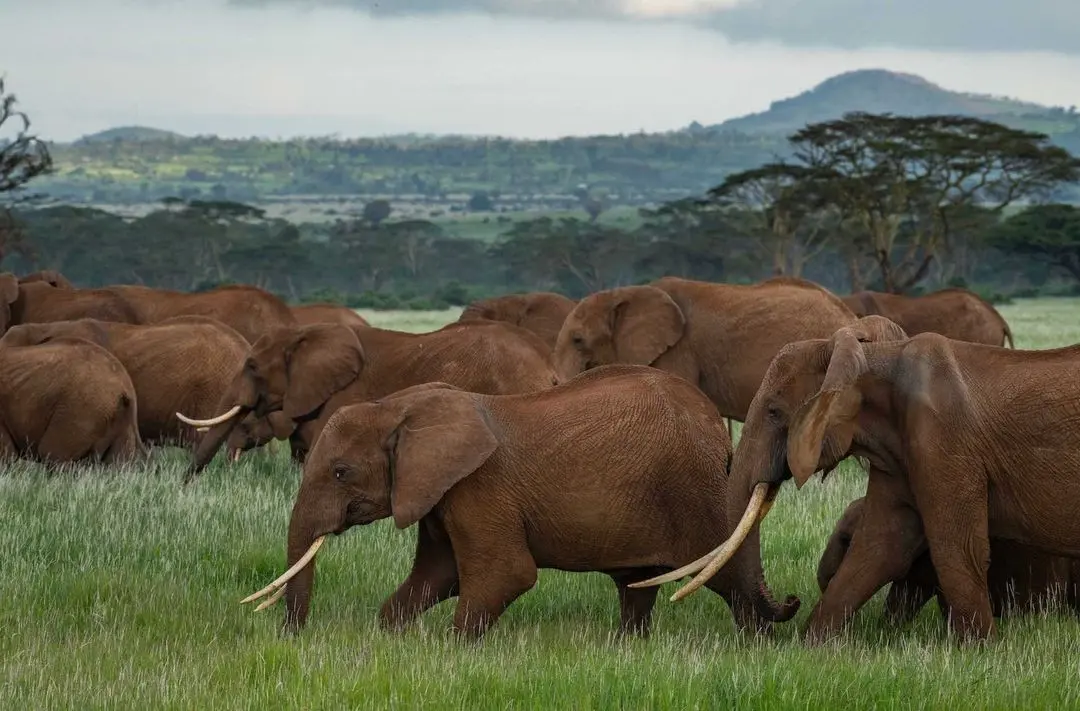
Mount Kenya National Park is a sanctuary for a rich
diversity of wildlife, making it a prime destination for nature lovers and
wildlife enthusiasts. The park's varied ecosystems, ranging from montane
forests to alpine zones, provide habitats for numerous species. Visitors can
encounter a wide array of animals, including:
- Elephants:
These majestic creatures are among the largest inhabitants of the park,
often seen roaming in the lower forested areas.
- Buffaloes:
Herds of buffaloes are a common sight, contributing to the park's vibrant
wildlife.
- Monkeys:
Various species of monkeys, including the black-and-white colobus monkey
and the sykes monkey, are frequently spotted in the park.
- Leopards:
Though elusive, leopards inhabit the park and add to the excitement of
wildlife sightings.
- Antelopes:
Species such as bushbucks and duikers are found in the park's diverse
habitats.
Animal Species and Bird Diversity at Mt. Kenya
Mount Kenya National Park is also home to several notable
and rare species. Among them are the Mount Kenya mole rat, a unique rodent
species adapted to the high-altitude environment, and the montane viper, an
endemic snake species.
The park's birdlife is equally impressive, with over 130
bird species recorded. Birdwatchers can delight in spotting:
- Tinkerbirds
and Sunbirds: These small, colorful birds are often seen flitting
among the park's flowers.
- Augur
Buzzards and Verreaux's Eagles: These raptors soar above the park's
peaks, providing thrilling birdwatching opportunities.
- Abyssinian
Ground Thrush: A rare and sought-after species for avid birdwatchers.
The park's diverse flora supports a rich insect population,
which in turn attracts numerous bird species.
This intricate web of life highlights the ecological
significance of Mount Kenya National Park and its role in conserving Kenya's
natural heritage.
Geological Features and Landscapes
Glaciers and Their Current Status
Mount Kenya National Park is renowned for its stunning
glacial features, which are remnants of the mountain's icy past. The park
contains 12 glaciers, though they are rapidly receding due to the effects of
climate change.
These glaciers, such as the Lewis Glacier and Tyndall
Glacier, add a dramatic element to the landscape, with their brilliant white
ice contrasting against the dark rock of the mountain.
The retreat of these glaciers is a significant concern, as
they play a crucial role in the park's hydrology. The melting ice contributes
to the rivers and streams that originate from the mountain, providing vital
water resources for the surrounding ecosystems and human populations.
U-Shaped Glacial Valleys and Secondary Peaks
The park's landscape is characterized by several U-shaped
glacial valleys, which are evidence of the mountain's glacial history. These
valleys were carved by the movement of glaciers during the last ice age,
creating deep, sweeping depressions that are now home to unique vegetation and
wildlife.
The valleys, such as the Gorges Valley and Teleki Valley,
offer breathtaking vistas and are popular routes for hikers exploring the
mountain.
In addition to the main peaks of Batian and Nelion, Mount
Kenya features several secondary peaks that add to its rugged terrain. These
secondary peaks, including Point Lenana, provide challenging yet rewarding
climbs for adventurers.
The varied topography of the park, with its mix of high
peaks and deep valleys, creates a visually stunning and ecologically diverse
environment.
The combination of glacial features and dramatic landscapes
makes Mount Kenya National Park a unique and fascinating destination.
The park's geological history is on full display, offering
visitors a chance to witness the natural processes that have shaped this iconic
mountain over millennia.
Climate and Weather Patterns at Mount Kenya

Mount Kenya National Park experiences significant climate
variation due to its extensive elevation range. The climate at the lower
altitudes is generally warmer and more humid, characterized by dense montane
forests and bamboo zones.
As one ascends, the temperatures drop significantly, and the
environment transitions into heath and moorlands, eventually giving way to
alpine conditions near the peaks.
At higher elevations, the climate can be quite harsh, with
temperatures often dropping to around 4°C (39°F) or lower. The weather is
unpredictable, and conditions can change rapidly, especially above 3,000 meters
(9,800 feet).
This variability requires visitors, particularly climbers
and hikers, to be well-prepared for a range of weather conditions, including
sudden storms and cold temperatures.
Best Times for Visiting and Hiking Mount Kenya
The best times to visit Mount Kenya National Park are during the dry seasons, which occur from mid-January to late February and from August to September. During these periods, the weather is more stable, and the trails are less muddy, making it ideal for hiking and mountain climbing.
Read More: Entry fee and hiking rates for Mount Kenya
These months also offer clearer skies, providing better
visibility for the spectacular views that the park offers.
During the wet seasons, from March to June and October to
December, the park experiences heavy rainfall, which can make the trails
slippery and challenging to navigate.
However, the lush greenery and blooming flowers during these
months create a vibrant and picturesque landscape, which can be appealing to
nature enthusiasts and photographers.
Visitors planning to climb Mount Kenya should be aware that
the conditions at the summit can be extremely cold, with snow and ice present
year-round. Proper gear and clothing are essential for a safe and enjoyable
experience.
Additionally, acclimatization to the altitude is crucial to
prevent altitude sickness, and climbers are advised to take the necessary
precautions and plan their ascent carefully.
Hiking and Mountain Climbing
Popular Routes for Climbing Mount Kenya
Mount Kenya is a popular destination for hiking and mountain
climbing, offering several established hiking routes that cater to different levels of
experience and fitness. The most well-known routes include:
- Sirimon
Route: Starting from the northwest of the mountain, the Sirimon Route
is one of the most scenic paths, offering diverse landscapes and excellent
acclimatization opportunities. It is often used in combination with other
routes for a more comprehensive experience.
- Naro
Moru Route: This is the shortest and most direct route to Point
Lenana, the third highest peak. It is popular for its relatively easier
terrain and faster access, but it is also steeper in some sections, which
can be challenging.
- Chogoria
Route: Known for its stunning scenery, the Chogoria Route offers
spectacular views of the Gorges Valley and several beautiful tarns. This
route is considered one of the most picturesque and is often combined with
the Sirimon Route for a varied trekking experience.
- Burguret
Route: This less-traveled path provides a more solitary and wilderness
experience. It is a tougher and longer route, recommended for more
experienced hikers looking for a challenge.
- Timau
Route: Another less-frequented route, Timau offers a quieter trek with
less crowded trails. It provides a unique perspective of the mountain's
northern slopes.
Tips for Climbers and Hikers
- Acclimatization:
Due to the high altitude, proper acclimatization is crucial to prevent
altitude sickness. It is recommended to spend several days acclimatizing
and to follow a gradual ascent.
- Weather Preparedness: The weather on Mount Kenya can change rapidly, especially at higher elevations. You should know the best time for hikers to climb Mt. Kenya and be prepared for cold temperatures, wind, and sudden storms. Layered clothing, waterproof gear, and thermal wear are essential.
- Physical
Fitness: Climbing Mount Kenya requires a good level of physical
fitness. Training and preparation, including cardiovascular and strength exercises,
can enhance the climbing experience and reduce the risk of injury.
- Guides
and Porters: Deciding whether to take a guided mountain hike or unguided hike should be difficult as we recommend guided hikes. They provide valuable assistance, local knowledge, and
support, making the climb safer and more enjoyable.
- Permits
and Regulations: All climbers need to obtain permits from the Kenya
Wildlife Service (KWS). It is important to follow the park's regulations
and guidelines to ensure conservation and safety.
Mount Kenya's diverse routes offer a range of experiences, from challenging climbs to scenic treks, making it a must-visit destination for adventure seekers. For best hiking experience, please learn about safety tips for hikers when hiking Mount Kenya.
Ecological and Environmental Significance
Role as a Water Catchment Area
Mount Kenya National Park plays a crucial role as a major
water catchment area, providing freshwater resources to a significant portion
of Kenya. The park's glaciers, rivers, and mineral springs are vital sources of
water for both wildlife and human populations.
The Tana and Ewaso Ng'iro rivers, which originate from the
slopes of Mount Kenya, are among the most important waterways in the region.
These rivers support agricultural activities, hydroelectric power generation,
and domestic water supply, highlighting the park's importance to the country's
water security.
Unique Flora and Endangered Species
The park is home to a diverse range of plant species, many
of which are unique to the afro-alpine environment of Mount Kenya. This
includes giant groundsels, lobelias, and various species of heather, which are
adapted to the high-altitude conditions.
The park's flora is divided into distinct zones based on
elevation, each supporting different types of vegetation.
Mount Kenya National Park also serves as a sanctuary for
several rare and endangered species. Notable among these are the Mount Kenya
mole rat and the montane viper, both of which are endemic to the region.
The park's diverse habitats support a wide array of
wildlife, including large mammals like elephants and buffaloes, as well as
numerous bird species.
Conservation Efforts at the Mountain
Efforts to conserve Mount Kenya National Park are critical
to maintaining its ecological integrity and biodiversity. The park is managed
by the Kenya Wildlife Service (KWS), which works to protect its natural
resources and wildlife.
Conservation initiatives include anti-poaching measures,
habitat restoration, and community engagement programs to promote sustainable
use of the park's resources.
The park's designation as a UNESCO World Heritage Site and
Biosphere Reserve further underscores its global ecological significance.
These designations help attract international support and
funding for conservation efforts, ensuring that the park's unique ecosystems
are preserved for future generations.
Mount Kenya National Park's ecological and environmental significance cannot be overstated. Its role as a water catchment area, home to unique flora and fauna, and ongoing conservation efforts make it a vital natural resource for Kenya and the world.
